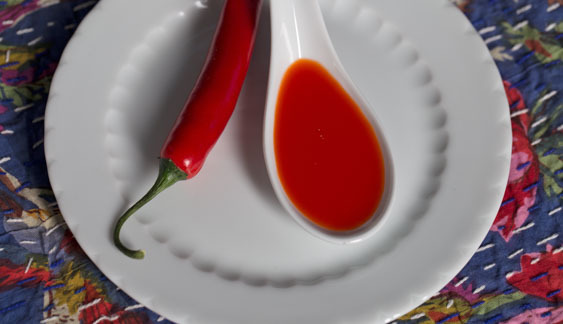Fresh Red Chile Hot Sauce

introduction
We are crazy about hot sauce. Who isn’t? We love to watch it stain a plate of scrambled eggs or avocado toast and to taste its bright, high notes against a tableau of creamy neutral flavors. We’re not crazy about hot sauces whose tank-y fermented garlic stomps on the chiles’ soaring fruit. Or those so fiery they hit your tongue like a blast furnace.
This chile sauce—more elegantly warm than hot—hews to the floating flavor and texture tropes of the pre-Columbian chile water served with nixtamal flat breads. We developed this sauce specifically to accompany our Fresh Hominy Grits. Imbued with the dynamics of slightly sweet, crimson-red fresh chile flavor but almost none of the chile flesh, the sauce’s gentle, round acidity complements any dish that has a taste for adventure.
Cooking Notes
Skip the temptation to go “Hell Night” on this sauce with an outrageously spicy chile selection. Skip the ghost chiles and habaneros altogether, and use only 1 or 2 Thai chiles, if you absolutely must.
equipment mise en place
For this recipe, you will need thin rubber gloves, a sharp paring knife, a food processor, a rubber spatula, a clean pint-size glass jar with a lid, a blender, a fine-mesh strainer, and a small nonreactive saucepan.
-
-
9ounces fresh hot red chiles (such as red Fresno chiles, red jalapeños, cherry peppers—use a mixture or a single type)
-
1medium garlic clove, peeled
-
1slender wedge of Vidalia onion or other sweet onion (0.6 ounces), peeled
-
1scant teaspoon fine sea salt
-
6ounces distilled white vinegar
-
-
Turn the chiles into a colander (fig. 1.1) and wash them well. Draw on a pair of thin rubber gloves. Using a sharp paring knife, trim off and discard the tops from the chiles. Slice off the tips and reserve. Cut each chile in half lengthwise and cut out the ribs and seeds (fig. 1.2). A few remaining seeds are fine, but too many will substantially increase the heat quotient of your final sauce. Cut the chiles into reasonably even ¼-inch dice. Coarsely chop the garlic and onion.
-
In the bowl of a food processor, combine the chiles, garlic, onion, and salt and pulse until the pieces are fine but not ground up, 10 to 15 quick bursts (fig. 2.1). Pour the vinegar into the food processor and, with a rubber spatula, slosh the chiles around to get them unstuck from the sides of the processor. Transfer the mixture into a clean pint-size glass jar with a lid, cover tightly, and let macerate at room temperature for at least 24 hours or for up to 2 days (fig. 2.2).
-
Pour the entire contents of the jar into a blender and process on high until well puréed, about 10 seconds. Wash and dry the jar. Set a fine-mesh strainer over a small nonreactive saucepan, pour the purée into the strainer, and use the rubber spatula to push as much of the pulp as possible through the strainer (fig. 3.1). Set the pan over medium-low heat and warm the sauce as briefly as possible to set the color and flavor—no more than a minute. Pour the sauce back in the jar (fig. 3.2). Seal tightly and refrigerate. The sauce will keep for up to 3 weeks at optimum flavor.
-
-
1.1

-
1.2

-
-
-
2.1

-
-
-
3.1

-